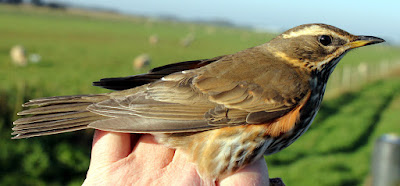One day a week for ringing. That’s all we get at the moment. One day without rain, wind or both. This week was Wednesday with a cold, clear and frosty start at Oakenclough where I met Andy at 0630. We were later joined by our old mate Will, now too busy with work to do a great deal of ringing. That’s his story and he’s sticking to it.
The morning followed a similar pattern to our latest visits here, a post-dawn burst of thrushes and then little else to keep feet and fingers warm. We are now past the peak of Redwing migration and while Fieldfares are often a week or two after the passage of Redwings, this autumn’s Fieldfare migration has seemed a little thin over here on the west coast. Blackbirds were more in evidence today with “continental” types caught, up to 20 seen in total, plus a single Song Thrush. Otherwise, and in the very clear skies there was a thin passage of Chaffinches overhead with at least two definite Bramblings, their nasal calls singling them out for special attention.
The peak numbers came about 0715 with a largish mixed flock of about 200 Redwing/Fieldfare at 30/70% respectively and which hurried through towards the west before we had time to scrutinise the flock more closely. Afterwards any newly arrived thrushes consisted of small groups or even singles of Fieldfares, Redwings or Blackbirds.
In all we caught 18 birds: 5 Blackbird, 2 Redwing, 1 Fieldfare, 4 Coal Tit, 3 Blue Tit, 2 Lesser Redpoll and 1 Goldcrest.
Fieldfare
Redwing
Fieldfare
Redwing
Lesser Redpoll
The route back home took me across Pilling/Rawcliffe Moss where 8+ Buzzards circled above a wood, 40 Fieldfares along a hedgerow and a single hovering Kestrel close by.
At Cockerham, Gulf Lane I stopped to count the Linnets and to leave their rape/millet mix which they are yet to exploit. Here were 145 Linnet, 4 Stock Dove and 1 Stonechat.
With luck this will be our next day and location of ringing – next Monday looks OK at the moment but these pencilled in days have a habit of changing. If the Met Office can’t predict more than 24 hours ahead what chance do we have?
Linking today to Anni's Birding and Eileen's Blog.
Linking today to Anni's Birding and Eileen's Blog.













































































